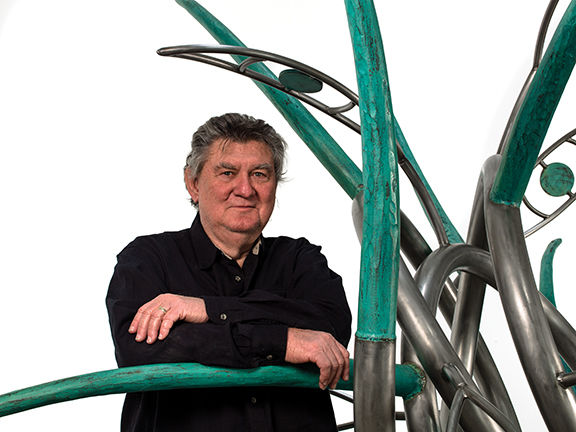By Tom Geddie
As a child growing up in East Texas, James Surls spent a lot of time making things. He didn’t call it art; it was just stuff he made because he was passionate about it.
As an adult, he’s been called “one of the most important sculptors working in America today,” recognition he’s proud of but embraces with a bit of humility.
Although he lives in Colorado these days, he was honored in March with the Texas Medal of Arts, joining the likes of Walter Cronkite, Tommy Lee Jones, Lyle Lovett, Willie Nelson, Robert Rauschenberg, ZZ Top, Laura Bush, and the other 2013 honorees — a list including the Houston Ballet, Fort Worth’s Kimbell Art Museum, actress Eva Longoria, and theater’s Joe Sears and Jaston Williams of “Greater Tuna” fame.
Surls calls the Texas honor a “big deal.”
He’s just a bit more reluctant about being called important.
“There are a lot of important artists in America today, and I don’t even know how necessarily well known they are. Fame is not equitable to talent, so that’s tricky territory in one way,” he said. “I like being honored; most people do. I like getting this award for Texas artist of the year. As to whether or not I’m really the most important or one of the most important artists, I wouldn’t say, ‘Oh that’s BS, I like that.
“A person doing a General Motors commercial on TV is probably more well known than the best artist in the country,” he said. “Media creates recognition. That’s the nature of it. When I walk down the street, very few people ever know who I am, so I don’t have to worry about any ‘fame’ getting in my way.”
Surls is featured in the 2013 East Texas Artists & Sculpture Gardens Tour on April 27-28 in Malakoff, both through his presence and through his work, including the new, never-before-seen “Two Prisms.” That new piece will be among the pieces at the James Surls Sculpture Garden, a tribute to his father, Joe. (For more information, call 903.489.0897 or go to www.malakofftexas.com.)
Like his father and his brother, he always, it seems, made things. His work today reflects those influences and the time he spent in forests as a child.
“I didn’t call it art when I was a kid. I just loved to make little carts, wagons, tree houses, and other things. My dad was a builder. My older brother could build things that worked. He could take automobiles and watches apart and put them together and they worked. He built things that had a working reality. The things I built never did, but people always loved what I did, so I gravitated toward art.”
Surls, who also draws and makes prints, didn’t even call what he did “sculpture” at the time.
“Over a period of my early 20s, I just kinda became more and more focused and it was apparent that there was a name for what I did, and it was called art. I would say I got into it by osmosis.”
Each sculpture usually emerges from something Surls reads that reminds him of something from his life or his imagination.
“It’s usually from a poem, from a written word, from some kind of story, a tale if you will,” he said. “If you look at the titles, they usually are more than one word and the titles will have a poetic ring to them. As a rule, the titles come first, which means the idea is given credence by calling it something. Then you make the physical component of it.
“A person’s art has to come from a place. You get comfortable in your terrain and you use that, you draw from it. I conjure from the earth, the woods. Even the violent part of it. My stuff is all earth stuff. Sun and rain and wind and grass and birds and trees.”
His work — mostly metal and wood —is often called abstract, a term he doesn’t use; “expressionist” might be better.
“I like to make up, in a way, like kids play,” he said. “I was in essence making up things because I didn’t want to copy. I wasn’t trying to reproduce something. I was trying to make something new. I don’t use the word abstract, which has a connotation that people don’t know what it is.
“I just call it sculpture. I don’t categorize it. Art historians and critics try to categorize it, to know what discipline it fits into, what strata they can fit it into. No one else’s art looks like mine, so I don’t really know where to put it. It’s just my sculpture.”
Surls does accept the description of his work as “primal.”
“That means to me, it’s from below the level of consciousness, something that’s been with us forever, although I don’t know if forever exists in that context,” he said. “How long has the circle been around? A year? Ten thousand years? A hundred thousand years? Some of these forms and shapes become universal symbols and have been in our psyches for a long, long, long time — part of what I call the human condition. It doesn’t make any difference what continent someone is from, or in a sense what culture someone is from. It goes back to the beginning of our humanity. I think that’s what’s primal.”
Surls stays busy. He’s working on a commissioned, 18-foot sculpture for the hundred-year anniversary of the city of Clayton, Missouri; a 33-foot piece for the city of Houston; and a piece for Texas State University in San Marcos.
“If I don’t have anything pressing, I just make art. Even if nobody wants some of it. I just do it.”
Surls is successful enough that he’s able to innovate in the way he markets his art. His work remains in museums and galleries — including the Dallas Museum of Art, the Meadows Museum at SMU, the Modern Art Museum of Fort Worth, the Smithsonian American Art Museum in Washington DC, the Museum of Modern Art and the Guggenheim in New York City, and at the Tyler Museum of Art.
Now, collectors come to him. It’s a practice he’s honed for several years with his own event at the end of every July.
“Collectors, people interested in art, people who are in the business come to my place,” he said. “Sculpture is so hard to schlep around the country. If anybody’s interested, they can come to my studio. I’m kinda reversing the process.”


